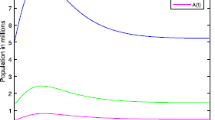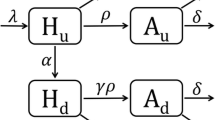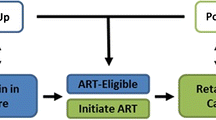Abstract
Antiretroviral-based pre-exposure prophylaxis (PrEP) treatment offers a new opportunity for protecting humans against HIV and disrupting current HIV prevention systems. However, implementing this preventive measure has been difficult due to its high cost. In this paper, we propose an age-structured model that incorporates infection ages, HAART (highly active antiretroviral therapy), and PrEP intervention. We investigate the qualitative behavior of the model and find a threshold parameter (the basic reproduction number) that determines the asymptotic stability of equilibria. We validate the model and estimate the parameters by confronting the actual HIV/AIDS data from 2004 to 2018 in China using MCMC (Markov Chain Monte Carlo) method. Furthermore, we investigate the PrEP intervention strategy by using incremental cost-effectiveness and average cost-effectiveness. Our work suggests that PrEP intervention based on the infection characteristics of different age groups can be an effective strategy to eradicate HIV/AIDS epidemics in China.














Similar content being viewed by others
Data availability statement
All used data are available on public databases.
References
Agusto F (2013) Optimal isolation control strategies and cost-effectiveness analysis of a two-strain avian influenza model. Biosystems 113:155–64
Angulo O, Lopez-Marcos JC, Milner FA (2007) The application of an age-structured model with unbounded mortality to demography. Math Biosci 208:495–520
Angulo O, Lopez-Marcos JC et al (2010) A numerical method for nonlinear age-structured population models with finite maximum age. J Math Anal Appl 361:150–160
Breda D, Falorian F, Ripoll J, Vermiglio R (2021) Efficient numerical computation of the basic reproduction number for structured populations. J Comput Appl Math 384:113165
Chang K, Zhang Q (2022) Numerical approximation of basic reproduction number for an age-structured HIV infection model with both virus-to-cell and cell-to-cell transmissions. Math Methods Appl Sci 44:12851–12859
Chavez CC, Feng Z (1998) Global stability of an age-structure model for TB and its applications to optimal vaccination strategies. Math Biosci 151:135–154
Data-Center of China Public Health Science (2021) Data directory. https://www.phsciencedata.cn/Share/en/index.jsp. Accessed 15 Mar 2021
Feng Z, Huang W, Chavez CC (2005) Global behavior of a multi-group SIS epidemic model with age structure. J Differ Equ 218:292–324
Feng Z, Feng Y, Glasser JW (2020) Influence of demographically-realistic mortality schedules on vaccination strategies in age-structured models. Theor Popul Biol 132:24–32
Gang H, Liu X, Takeuchi Y (2012) Lyapunov functions and global stability for age-structured HIV infection model. SIAM J Appl Math 72:25–38
Gao D, Munganga MW, Van Den Driessche P, Zhang L (2022) Effects of asymptomatic infections on the spatial spread of infectious diseases. SIAM J Appl Math 82:899–923
Guo T, Qiu Z, Kitagawa K, Iwami S, Rong L (2021) Modeling HIV multiple infection. J Theor Biol 509:110502
Hethcote HW (2000) The mathematics of infectious diseases. SIAM Rev 42:599–653
Kuniya T (2017) Numerical approximation of the basic reproduction number for a class of age-structured epidemic models. Appl Math Lett 73:106–112
Li X, Yang J, Martcheva M (2020) Age structured epidemic modeling. Springer, Cham
Manoj K, Abbas S (2022) Global dynamics of an age-structured model for HIV viral dynamics with latently infected T cells. Math Comput Simul 198:237–252
Martcheva M, Crispino-O’Connell G (2003) The transmission of meningococcal infection: a mathematical study. J Math Anal Appl 283:251–275
National Bureau of Statistics (2014) China Population and employment statistics yearbook 2014. http://www.stats.gov.cn/
National Bureau of Statistics (2021) China statistical yearbook. http://www.stats.gov.cn/tjsj/ndsj/2020/indexch.htm. Accessed 18 Jan 2021
Nelson PW, Gilchrist MA, Coombs D, Hyman JM, Perelson AS (2004) An age-structured model of HIV infection that allows for variations in the production rate of viral particles and the death rate of productively infected cells. Math Biosci Eng 2:267–288
Qiao Y, Xu Y et al (2019) Epidemiological analyses of regional and age differences of HIV/AIDS prevalence in China, 2004–2016. Int J Infect Dis 81:215–220
Qiu Z, Feng Z (2010) Transmission dynamics of an influenza model with age of infection and antiviral treatment. J Dyn Differ Equ 22:823–851
Rong L, Feng Z, Perelson AS (2007) Mathematical analysis of age-structured HIV-1 dynamics with combination antiretroviral therapy. SIAM J Appl Math 67:731–756
Stavros B, Chavez CC (1991) A general solution of the problem of mixing of subpopulations and its application to risk-and age-structured epidemic models for the spread of AIDS. Math Med Biol A J IMA 8(1):1–29
Sweeting MJ, Angelis D et al (2010) Estimating the distribution of the window period for recent HIV infections: a comparison of statistical methods. Stat Med 29:3194–3202
Wang X, Lou Y, Song X (2017) Age-structured within-host HIV dynamics with multiple target cells. Stud Appl Math 138:43–76
Wang L, Din A, Wu P (2022) Dynamics and optimal control of a spatial diffusion HIV/AIDS model with antiretroviral therapy and pre-exposure prophylaxis treatments. Math Methods Appl Sci 45:10136–10161
Webb GF (2008) Population models structured by age, size, and spatial position. In: Magal P, Ruan S (eds) Structured population models in biology and epidemiology, vol 1936. Lecture notes in mathematics. Springer, New York, pp 1–49
Wu Z, Wang Y, Detels R, Bulterys M, McGoogan JM (2020a) HIV/AIDS in China. Springer, Sinapore
Wu Z, Wang Y, Detels R, Bulterys M, McGoogan JM (2020b) HIV/AIDS in China: epidemiology, prevention and treatment. Springer, Singapore
Xue L, Jing S, Wang H (2022) Evaluating strategies for tuberculosis to achieve the goals of WHO in China: a seasonal age-structured model study. Bull Math Biol 84:1–50
Zhang Y, Cai C et al (2020) Disproportionate increase of new diagnosis of HIV/AIDS infection by sex and age-China, 2007–2018. China CDC Wkly 5:69–74
Zhao H, Wu P, Ruan S (2020) Dynamic analysis and optimal control of a three-age-class HIV/AIDS epidemic model in China. Discrete Contin Dyn Syst Ser B 25:3491–3521
Zheng T, Luo Y, Zhou X, Zhang L, Teng Z (2021) Spatial dynamic analysis for COVID-19 epidemic model with diffusion and Beddingtion–Dengelis type incidence. Commun Pure Appl Anal. https://doi.org/10.3934/cpaa.2021154
Acknowledgements
Research of PW is supported by the National Nature Science Foundation of China (No. 12201557), the Foundation of Zhejiang Provincial Education Department (No. Y202249921). Research of HW is partially supported by Natural Sciences and Engineering Research Council of Canada (NSERC) Discovery Grant RGPIN-2020-03911 and NSERC Accelerator Grant RGPAS-2020-00090.
Author information
Authors and Affiliations
Corresponding author
Additional information
Publisher's Note
Springer Nature remains neutral with regard to jurisdictional claims in published maps and institutional affiliations.
Appendices
Appendix A: The Collection of Real Data
To parameterize the continuous age-structured model for HIV/AIDS transmission in China, we first fit the reported cases from 2004–2018 (Data-Center of China Public Health Science 2021) by the demographic model (25). The numbers of reported HIV/AIDS cases for different age groups from 2004 to 2018 are displayed in Tables 8, 9 and 10.
Appendix B: Collection of Fitted Curves
The fitted curves of new and cumulative HIV/AIDS cases for different age groups are presented in Figs. 15, 16, 17 and 18.
Rights and permissions
Springer Nature or its licensor (e.g. a society or other partner) holds exclusive rights to this article under a publishing agreement with the author(s) or other rightsholder(s); author self-archiving of the accepted manuscript version of this article is solely governed by the terms of such publishing agreement and applicable law.
About this article
Cite this article
Wu, P., Ahmed, S., Wang, X. et al. PrEP Intervention in the Mitigation of HIV/AIDS Epidemics in China via a Data-Validated Age-Structured Model. Bull Math Biol 85, 41 (2023). https://doi.org/10.1007/s11538-023-01145-4
Received:
Accepted:
Published:
DOI: https://doi.org/10.1007/s11538-023-01145-4








